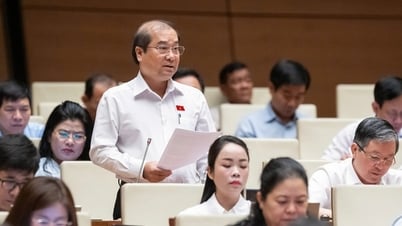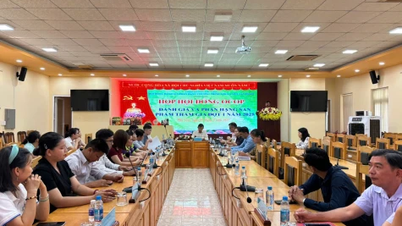If all points are deducted, you will have to retake traffic knowledge.
According to the law, each driving license has 12 points, used to manage the driver's compliance with the law on Road Traffic Safety and Order (RTOS) through the database system. If there is a violation, the driving license will be deducted the number of points corresponding to the nature and level of the behavior. Information on the driving license deduction points will be updated in the database system immediately after the penalty decision comes into effect and the violator is notified. The Government will specify in detail the violations that are subject to deduction of points, the deduction points for each violation, the order and procedures for deduction of points, and the restoration of driving license points.

From January 1, 2025, each driving license will have 12 points, used to manage the driver's compliance with traffic safety laws.
A driver's license will be restored with all 12 points if all points have not been deducted and no points have been deducted within 12 months from the date of the most recent deduction. If all points are deducted, the driver's license holder is not allowed to drive a vehicle with that type of license. After at least 6 months from the date of all points being deducted, he/she is allowed to participate in the test on knowledge of traffic safety laws organized by the traffic police. If the result is satisfactory, the driver's license will be restored with all 12 points.
The National Assembly Standing Committee (NASC) said that each year, about 500,000 driving licenses are revoked, making drivers not allowed to operate vehicles, significantly affecting travel, labor, production and business activities. Many violators accept to give up their driving licenses, leading to huge backlogs and waste. The regulation on deducting driving license points is more humane, if the points have not been deducted, the driver can continue to drive the vehicle, without affecting the activities as mentioned above.
There is a proposal to assign the Ministry of Transport to organize a test of legal knowledge on road traffic safety to restore driving license points, instead of assigning it to the traffic police force, to ensure consistency in state management of training, testing, and granting driving licenses.
The Standing Committee of the National Assembly said that the knowledge test in the above case is not a re-test for a driving license, but will have the same content as the theoretical test for a driving license. Assigning the test to the traffic police is appropriate, because this force is responsible for managing drivers participating in traffic after being granted a driving license, in terms of awareness, law compliance, health, psychology, spirit and traffic behavior.
Also related to driving licenses, the 2008 Road Traffic Law (currently in effect) stipulates that driving licenses include 13 classes: A1, A2, A3, A4, B1, B2, C, D, E, FB2, FD, FE, FC. According to the new regulations in the Road Traffic Safety Law, driving licenses will have many changes, including 15 classes: A1, A, B1, B, C1, C, D1, D2, D, BE, C1E, CE, D1E, D2E and DE.
Driving licenses issued before the effective date of the new law shall continue to be valid for the period stated on the driving license. Driver learners who have been or are being trained before the effective date of the new law but have not been tested and issued a driving license shall be tested and issued a driving license according to the new classification.
School buses must have "anti-forgetting" devices
A very important new content in the Law on Traffic Safety is to tighten regulations on ensuring traffic safety for cars carrying preschool children and students. This is expected to prevent recent incidents of leaving students in cars with heartbreaking consequences.
Specifically, vehicles used for transporting preschool children and students must ensure technical safety and environmental protection, and be equipped with journey monitoring devices and devices that record images of the driver. In addition, they must have devices that record images of preschool children and students and devices that have warning functions to prevent children from being left in the vehicle; must have a usage period of no more than 20 years; and must have paint colors according to government regulations. They must also have age-appropriate seat belts or use vehicles with age-appropriate seats according to the law.
When transporting preschool children and primary school students, each vehicle must have at least one manager to guide, supervise, maintain order and ensure the safety of preschool children and primary school students during the trip. In the case of a vehicle with 29 seats or more carrying 27 preschool children and primary school students or more, at least two managers must be arranged on each vehicle. The manager and driver are responsible for checking preschool children and primary school students when they get off the vehicle; preschool children and primary school students must not be left on the vehicle when the manager and driver have left the vehicle.
The law also states that drivers of cars transporting preschool children and students must have at least 2 years of experience driving passenger vehicles. Educational institutions must develop procedures to ensure safety when transporting preschool children and students; instruct drivers and managers of preschool children and students to understand and properly implement the procedures; and be responsible for ensuring order and road traffic safety when transporting preschool children and students of that educational institution.
During the law-making process, there were suggestions to regulate the responsibility for ensuring traffic safety in organizing the pick-up and drop-off of preschool children and students, not only for educational institutions and the education sector, but also the state management responsibility of agencies, units, and localities.
The Standing Committee of the National Assembly said that ensuring traffic safety in general is the responsibility of state management agencies and the whole society. However, the main responsibility for ensuring traffic safety in organizing the pick-up and drop-off of preschool children and students belongs to the educational institutions where preschool children and students study. Therefore, this content is regulated as stated.
Children under 10 years old are not allowed to sit in the front seat.
According to the provisions of the Law on Road Traffic Safety, drivers and passengers must wear seat belts in places equipped with seat belts when participating in traffic. Children under 10 years old and under 1.35 m tall are not allowed to sit in the same row of seats as the driver, except for vehicles with only one row of seats. Drivers must use and instruct on the use of appropriate child safety equipment.
In addition, children under 7 years old, the blind, and people with no civil capacity must be accompanied by adults when crossing the street. Everyone has the responsibility to help these people when crossing the street.
Traffic inspectors no longer have the right to stop vehicles.
The 2008 Road Traffic Law stipulates that two forces are authorized to stop vehicles, including traffic police and traffic inspectors (TTGT). From January 1, 2025, the Law on TTATGTDB stipulates that the only force authorized to stop vehicles is the traffic police (or other forces in the People's Public Security mobilized to coordinate). This is consistent with the Road Law also recently passed by the National Assembly, when it stipulates that TTGT has the task of inspecting, checking, and handling violations at "static" traffic points such as transport units, bus stations, parking lots, rest stops, etc.
The above change aims to ensure consistency and avoid overlapping functions and tasks between the Traffic Police and Traffic Police, and to avoid inconvenience to road users when there are many competent forces handling violations on the road.
Source: https://thanhnien.vn/giay-phep-lai-xe-co-12-diem-tru-het-se-khong-duoc-lai-trong-6-thang-185240629225922089.htm


![[Photo] National Assembly Chairman works with leaders of Can Tho city, Hau Giang and Soc Trang provinces](https://vphoto.vietnam.vn/thumb/1200x675/vietnam/resource/IMAGE/2025/5/11/c40b0aead4bd43c8ba1f48d2de40720e)
![[Photo] Prime Minister Pham Minh Chinh chairs the fourth meeting of the Steering Committee for Eliminating Temporary and Dilapidated Houses](https://vphoto.vietnam.vn/thumb/1200x675/vietnam/resource/IMAGE/2025/5/11/e64c18fd03984747ba213053c9bf5c5a)
![[Photo] The moment Harry Kane lifted the Bundesliga trophy for the first time](https://vphoto.vietnam.vn/thumb/1200x675/vietnam/resource/IMAGE/2025/5/11/68e4a433c079457b9e84dd4b9fa694fe)
![[Photo] Discover the beautiful scenery of Wulingyuan in Zhangjiajie, China](https://vphoto.vietnam.vn/thumb/1200x675/vietnam/resource/IMAGE/2025/5/11/1207318fb0b0467fb0f5ea4869da5517)




























































































Comment (0)